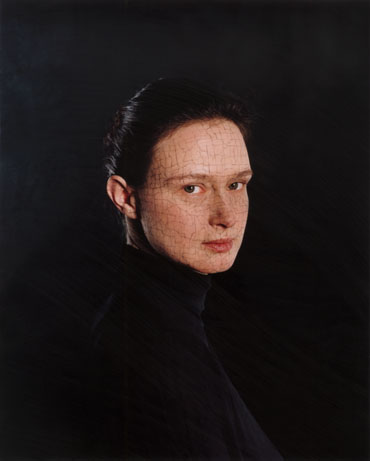 |

Foto: Anneè Olofsson
"Will You Still Love Me Tomorrow" 2004
c-print, 125 x 100 cm.
|
 |
Anneè Olofsson WILL YOU STILL LOVE ME TOMORROW
27 augusti – 2 oktober
Anneè Olofsson har fått stor internationell uppmärksamhet sedan hennes arbeten visades utanför Sverige för första gången i 1998. Hon deltar just nu i utställningarna ”Making Faces. The Death of The Portrait” (producerad av Museè de L´Élysèe in Lausanne, visas nu på Hayward Gallery i London) och ”body:building” på SF Camerawork i San Francisco.
Anneè Olofssons senaste fotografiska serie heter ”Will You Still Love Me Tomorrow? Den består av åtta närbilder av kvinnoansikten i tre kvarts profil, som vrider huvudet över axeln och tittar in i kameran. Kvinnornas ansikten är täckta av ett fint mönster med linjer som liknar krackeleringen på en åldrande målning.
Seriens titel ger en antydan om bildernas flerskiktade tematik. Anneè Olofsson refererar med dessa bilder till den mänskliga fåfängan såväl vår kulturs fixering vid det som är nytt och oförbrukat. En kvinnas skönhet lika väl som en målning går oundvikligen mot i ett stadium av förfall. Konstnären ställer frågor kring hur vi värdesätter konstverket, i takt med tidens fluktuerande smakriktningar, samtidigt som fotografiet gör anspråk på att ta måleriets plats.
Det djupare liggande temat, som ofta i Anneè Olofssons verk, har att göra med den yttersta av alla mänskliga rädslor, rädslan för döden.
Anneè Olofsson has attracted widespread international attention since the first introduction of her work outside Sweden in 1998. Her work is currently being exhibited in “Making Faces. The Death of the Portrait” (produced by Museè de L´Élysèe in Lausanne, now being shown at Hayward Gallery in London) and “body:building” at SF Camerawork in San Francisco.
Anneè Olofssons latest photographic series is entitled “Will You Still Love Me Tomorrow?” The eight images are close-up portraits of women against a dark background, turning their heads over their shoulder to look into the camera. The faces are covered with finely drawn lines that resemble the cracked surface of an aging painting.
The title of the series implies multi-layered metaphores. Olofsson refers to human vanity and our culture´s obsession with youthful beauty and the New. Beauty, whether in a painting or a womans face, moves inevitable toward a state of decay. The artist raises questions about our esteem of the Work of Art as our tastes fluctuate over time, and as the photograph takes over the position of painting.
The underlying theme, as often in Anneè Olofssons work, is the deepest of all human fears, the fear of death.
|
|  |
|









